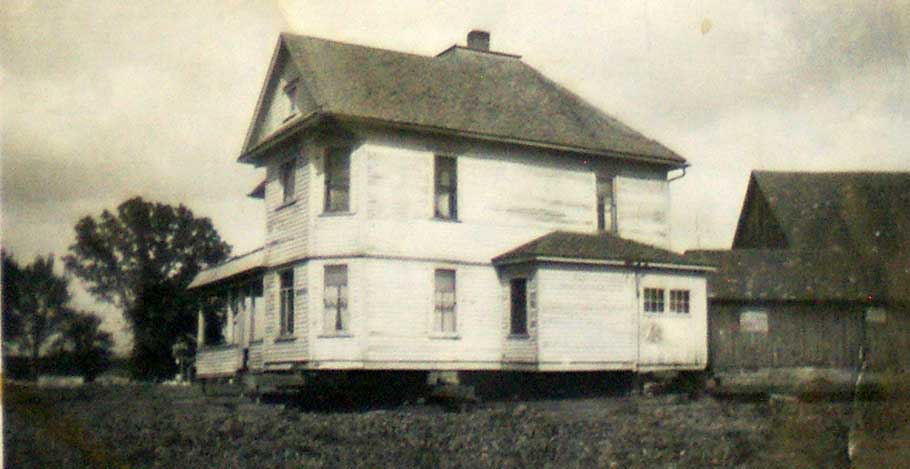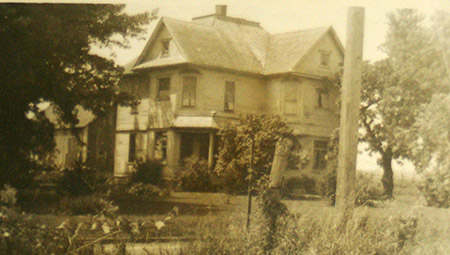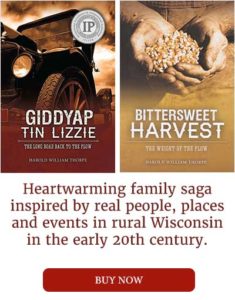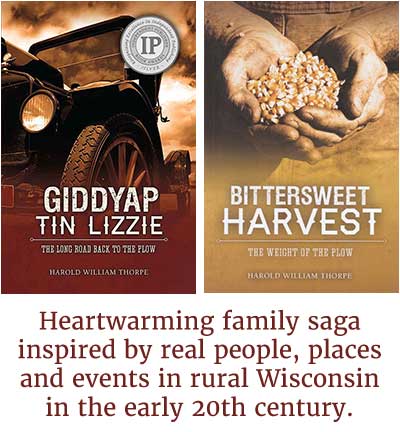“Sharon, who was now twenty-one years old, had completed her teaching preparation and would now go to Ed Meadow’s farm home near Logan Junction, where she had taken a teaching position just outside of town.” – Bittersweet Harvest
The story of my cousin’s fourth-generation Iowa County farm is also the story of a highway.
My cousin, Wayne Paull, lived on a 196-acre farm along US Highway 18/151 until a few weeks before his death in July 2016. The farm had been in Wayne’s family since 1898. Just east of Ridgeway, past a bend in the road, is their driveway turn-off.
In Wayne’s lifetime, the highway has gone from a narrow expanse of crushed gravel to a two-lane cement road to a four-lane divided highway that now bypasses the small towns it once wound through. For the past 116 years, from their front yard, the Paulls have watched the changes.
I spent a lot of time at the Paull’s farm as a child. And I knew, when I sat down to write my O’Shaughnessy Chronicles novels, based on my real-life Iowa County family history, that it had to fit in somewhere.
The farm comes in midway through Bittersweet Harvest. Sharon O’Shaughnessy and her husband, Ed, move to his family farm near Logan Junction, Wisconsin. Logan Junction is the fictional name I gave to Ridgeway. Wayne’s parents, my Aunt Anne and Uncle Earl Paull, inspired the fictional Sharon and Ed.
In real life, Wayne’s grandparents built their house in 1904, six years after buying the farm. The barn followed in 1908. Both the original barn and house are gone now, replaced with modern structures.
In 1920, the year Aunt Anne and Uncle Earl were married, the first tractor arrived on the farm.
Wayne was born in 1928. Two years prior to that, in 1926, the highway saw its first major change in the twentieth century. It was the first of many changes to come.
Prior to 1926, the narrow gravel road that passed by their house was part of Wisconsin State Road 19.
In 1926, this stretch past Ridgeway was renamed to become part of US Highway 18. In 1922, in preparation for future expansion of the road, the Chicago and Northwest Railroad railroad tracks across from the Paull’s farm were rerouted a few dozen yards to the north. For the time being, the road would remain crushed gravel, but the Paull’s view now flip-flopped. Where they previously had to cross the railroad tracks to reach the highway, now the tracks lay beyond the road. Today, that former rail corridor is part of the Military Ridge recreational trail that runs parallel to US 181/151, across from the Paull’s farm, on the north side of the highway.
The route’s full history goes back nearly two centuries.
What today is US 18/151 was, in the 1800s, a dirt path called the Military Ridge Road. Built in the 1830s, it was one of the first real roads in the state of Wisconsin.
Highway construction in Wisconsin leaped forward early in the twentieth century.
The Wisconsin State Trunk Highway System was created in 1917. The goal was to reach via a state highway every county seat in Wisconsin and every community with a population of 5,000 residents or more, and to post good signs on those routes. A year prior to that, in 1916, the US Congress had passed the first Federal Road Act, to help states fund the creation of their highway systems.
In those days, state highways weren’t just for motor cars. In the early 1920s, traffic counts taken by the state Highway Commission, as vehicles passed by counting stations, included not just cars, trucks and motorcycles – but also “horse drawn vehicles.”
To help fund the expansion of its state highways, the Wisconsin Legislature passed its first motor vehicle tax – two cents per gallon — in 1925. Wisconsin also created its County Trunk Highway System in 1925. Interstate highways would follow a few decades later, in the 1950s.
In 1938, when Wayne was ten years old, a second major change occurred in the stretch of highway past the Paull’s farm. The gravel road was replaced by a much wider, cement, two-lane highway that combined for the first time, along one corridor, US Highways 18 and 151.
DOT records show that, between 1936 and 1938, US Highway 151 was extended southward from Madison into the state of Iowa. US Highway 18, meanwhile, was also reconstructed in that biennium southward from Madison. Signage for US Highway 18 and 151 was then officially converged between Dodgeville and Madison to become US 18/151, a designation that still holds today.
Wayne vividly recalls when that two-lane, cement road went in in 1938.
It sticks in his mind because of the changes that had to occur on the farm to make way for it.
The farmhouse his grandfather had built thirty-four years earlier had to be lifted off its foundation and moved back, out of the way of the widened route. Today, the northbound lanes of US 18/151 pass over the Paull’s original home site.
It wasn’t the last time the family would be asked to move out of the way of the ever-expanding highway.
In the 1980s, their grainery had to move back to make way for an even bigger, four-lane, divided road.
And more changes are to come. In 2012, about 16,000 cars passed by Wayne’s farm each day. The Wisconsin Department of Transportation estimates that will rise to about 19,000 by 2017.
That’s a huge leap from just a few decades ago. In 1982, DOT records show, only about 5,000 cars went by Ridgeway each day on US 18/51.
Increasingly concerned about accidents due to cross traffic, the DOT is now considering closing off all local access points along US 18/151 between Dodgeville and Verona, including the Paull’s driveway.
A proposed interchange a half-mile west of their farm would become their access to the highway.
How that will yet again change the look of the farm remains to be seen.
Change has been a constant for the highway. What remains constant, too, however, are our wonderful memories of the years spent on the farm.
Over the decades, the Paulls have raised dairy and beef cattle, sheep, and pigs. The family, at various times, has grown corn, oats and hay.

Cattle on the farm today
Today, it’s a dairy operation run by Wayne’s son, Terry.
Wild deer, pheasants, and turkeys still roam the thick woods.
Wayne can tell lots of stories from over the years about cars that skidded off the highway and ended up on their lawn. His family members have been – perhaps more times than they care to count — the first on the scene to aid injured motorists.
It wasn’t always accidents in which the Paulls came to the rescue, though. Motorists who ran out of gas, or had other car trouble along what was once a remote stretch, often knocked on their kitchen door.
Those unexpected visitors turned up at any time, day or night. Though they had little themselves in the way of material things, Wayne recalls that his parents were generous in doling out comfort. Stranded motorists got sandwiches and coffee, and a bed if needed.
My memories of the Paull’s farm were of a visiting cousin. I remember playing cowboys and Indians in the yard with Wayne’s sister, Barb, pretending to shoot at passing cars on the highway.
We played in the woods, picked watercress, raspberries, and blackberries, and climbed on rock outcroppings. The rock outcroppings, especially, were my playground, the Price Valiant Castle of my childhood imagination.
I skied there on an old pair of wooden skis, and spent a lot of hours inside the house playing games with my cousins and Aunt Anne.
When I visit Wayne today, we recall those bygone times. We marvel at how the highway has changed. We enjoy looking at photo albums together, remembering. I am glad that I was able to find a place in the O’Shaughnessy Chronicles for the Paull’s Ridgeway farm.












